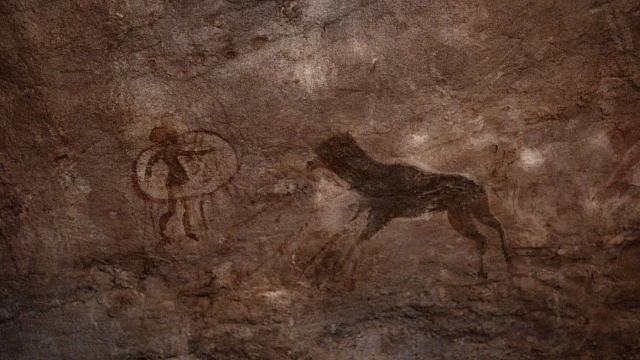The rock art of Tassili n'Ajjer is mysterious; Lydia Ourahmane's wordless film of the drawings is hy
KATE TAYLOR
PUBLISHED FEBRUARY 15, 2023
- click for image -
https://tinyurl.com/tk6srfar
Artist Lydia Ourahmane is photographed in front of her installation at Mercer Union gallery in Toronto on Jan. 27.
JENNIFER ROBERTS/FOR THE WASHINGTON POST
In the Sahara Desert, on a vast plateau in southeastern Algeria near the border with Libya, there stands a dense grid of eroded sandstone, a maze of canyons, spires and hoodoos. This is Tassili n’Ajjer, or the Plateau of Rivers, a landscape once carved by water, now sculpted by wind. A UNESCO World Heritage Site and Algerian national park, it is geologically dramatic but also uniquely marked by humans: On its rock walls are hundreds of figures, human and animal, realistic and surreal, carved or painted in several different Neolithic periods, as far back as 10,000 to 12,000 years ago, when the area was a fertile savannah.
This remarkable place, considered one of the most important collections of prehistoric rock art in the world, is also uniquely inaccessible: Large sections have been closed to foreign tourists and it takes days of hiking with local guides and pack animals to see much of the rock art. In an act of metaphysical exploration, the Algerian artist Lydia Ourahmane did just that to make Tassili, a wordless and hypnotic 47-minute film that reveals the landscape and the rock paintings, and is now showing at the Mercer Union gallery in Toronto.
“It’s one of the most powerful experiences I have ever had with a geographic region,” Ourahmane said in a recent interview. “It’s powerful for me because, as someone who makes things, as an artist, I am very aware of what I am bringing into this world and what am I leaving in it. What do I deem worthy or urgent to produce? Will it be meaningful to people beyond this moment in time? The fact these paintings can still communicate after 12,000 years, the fact we can still look at them and recognize what these people were saying, is profound.”

A still from Lydia Ourahmane’s Tassili.
COURTESY THE ARTIST
But what exactly the prehistoric artists were saying has been the subject of some debate since the controversial French anthropologist Henri Lhote led expeditions to Tassili from the 1930s through the 1950s, copying the art using destructive techniques such as tracing or washing the rock to brighten the colours. Some of the drawings and engravings are clearly records of daily life, showing cattle and people, often with remarkable naturalism, but others, with masked or horned figures, oversized bulbous heads, and odd protrusions have led to much speculation, mainly about spiritual practices, but also far-out theories of prehistoric contact with aliens.
More:
https://archive.ph/XCar0#selection-1403.0-1411.659
